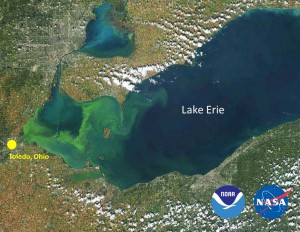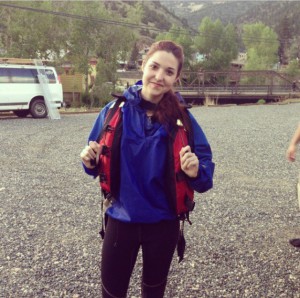
By Kateland Kirk
Harmful algal blooms (HABs) in lake Erie have been the topic of many environmentalists’ conversations for the past several years. But why? Could it be due to its rising threat to the people who rely on lake Erie for safe drinking water or maybe the ecosystems that it is putting in danger? Sadly before I started my research for National Oceanic and Atmospheric Association (NOAA) I had no idea that this was even a problem . and I have lived in Ohio my whole life. Many Ohioans don’t know that HABs are a threat to their health, their family’s health, and yes even the beloved family pet!
What causes HABs you might ask. Something called nutrient overload, primarily phosphorus, nitrogen and carbon. These elements overfeed the algae found in waterways, and just like children going through growth spurts it seems like the more you feed them the more they grow. Once the algae has taken over it starts rising to the surface of the water and will move with water currents or if weather pushes them into another area. If this wasn’t bad enough some of these algae produce toxins that can be harmful for consumption, breathing or touching.
Now you may be wondering where does this nutrient overloading come from? This is actually not as easy to answer. Many sources contribute to the problem of nutrient overloading, but farmers are frequent targets for those lobbying to reduce nutrients. So much so that there has actually been legislation passed to actively decrease the amount of phosphorus output caused by farmers by 40 percent by 2025. Farmers use a lot of fertilizer to help their crops grow so that we don’t have food and fuel shortages or price jumps; this fertilizing comes with bad effects though. More fertilizer means more nutrients in the ground that can make their way to water sources when bad weather hits. It is the heavy rains that wash all these nutrients to our water sources. Though farmers do contribute largely to the problem of nutrient overloading so do many other aspects of human life. Waste management companies and contained animal feeding operations (CAFOs) also contribute to this problem, just in an even more unpleasant way of thinking about it. Some waste treatment companies treat what comes in with chemicals and then releases it back into the water. This sewage water now not only contains the elements that cause HABs but also a lot of other bacteria that is not safe for living creatures. CAFOs put in untreated waste, that contain nitrogen and phosphorus, into our water supplies through runoff. There are still many other sources that contribute to the HABs problem that are often overlooked, think of golf courses. They use fertilizer to keep their grass extra green and look how much land they have.

HABs are a rising problem everywhere in the nation. More people means more pollution which along with other environmental factors can lead to even worse HABs. This is why so many organizations have been doing their part to keep people up to date with information. NOAA uses satellites to track blooms and post operational bulletins for parts of The Gulf of Mexico that affect Florida and Texas and are doing demonstration projects for lake Erie. Every year they put out forecasts predicting how bad the bloom will be for the year and where the bloom is moving. The bulletins for lake Erie are in the midst of being transitioned to operations, and NOAA is working to get the forecasts taken for the Gulf of Maine to be transitioned next. The Environmental Protection Agency (EPA) put out guidelines in 2015 for safe drinking water standards, after the bloom last year left almost half a million people in Toledo Ohio without safe drinking water. While doing research on the newly published guidelines I found that the public had many mixed reviews. While most of the public welcomed the new guidelines and saw this as a step in the right direction a small portion of the public still do not think that the government can or will handle this problem. There is still a push for the EPA to also put out guidelines for safe recreational water and prevention guidelines. Many government agencies take harsh criticism for not doing enough, but honestly there are way more civilians than government employees and policy makers so it comes down to citizens having to do their part as well. People don’t realize that: results cannot be seen overnight, what may be needed to fix the problem is not always the easiest or cheapest solution, and that we all play a part in the cause and solution of this problem. No one wants to think that something like this could hit so close to home or even affect them, but it can. Lake Erie is only a couple hours away from me and our tap water supplies pull from Lake Erie, it is scary to know that it was so close to home but even more scary to know I knew nothing about it and I’m still not the only person in the dark.
Kateland Kirk is a sophomore at Columbus State University and an NCCOS intern supporting harmful algal bloom and contaminant monitoring research.
